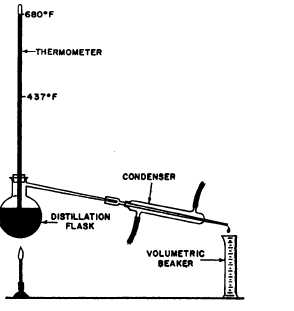specifications, and for establishing safe handling
procedures.
Bituminous materials are manufactured to meet
specifications established by the federal government,
American Association of State Highway and
Transportation Oficials (AASHTO), and American
Society for Testing and Materials (ASTM). These
specifications define the extreme limits permitted in the
manufacture of the material and assure the user that the
material will possess definite characteristics and fulfill
the project requirements. Some of the different tests the
EA should be able to perform in the laboratory are
discussed below. Other tests that you are less likely to
perform, but should be aware of, are discussed in
NAVFAC MO-330.
Identification Tests
The laboratory identification kit for bitumens
consists of a number of jars containing samples of
bitumens in all the recognized categories. To use this kit,
you must bring an unidentified sample to approximately
the same temperature as the kit samples, and then,
following instructions that come with the kit, make
identification on the basis of similarity of color, feel,
consistency, and odor.
A bituminous material suitable for use in pavement
has a considerably higher ductility (which may be
roughly defined as stretchability) than one that is
suitable only for use as a waterproofer, roofing binder,
or crack filler. Any crude method of determining the
presence or absence of ductility (such as stretching the
material like an elastic) will indicate whether or not the
unidentified samples lies somewhere in the category of
pavement material.
Distillation Test
If the unknown bitumen proves to be an asphalt and
has an odor that indicates the presence of a distillate
(such as the odor of kerosene or naphtha), a distillation
test will indicate the character and approximate grade.
In making this test, bear in mind that the basic material
for RC and MC is asphaltic cement; that is, penetration
asphalt. The basis for SC, however, is not asphaltic
cement, but an asphalt residual oil too fluid to be
penetration-tested for grade.
RC, MC, and SC all contain a distillate; that is, a
volatile liquid that evaporates during the curing process.
For RC and MC, the distillate is highly volatile and
evaporates quickly; for SC, it is considerably less
volatile.
The grade of RC, MC, or SC increases with the ratio
of bitumen to distillate. Obviously, the higher the
percentage of bitumen, the more solid the material will
be, and, therefore, the higher the grade. For RC and MC,
the percentage of bitumen for a given grade is the same,
as shown in the following example:
These figures mean that for MC-30, for example,
the percentage of bitumen is 54—the percentage of
distillate being determinable, of course, by subtracting
the percentage of bitumen from 100.
For SC the bitumen percentages are somewhat
lower as follows:
From the distillation test, you can determine the
bitumen percentage and whether the material is SC, RC,
or MC. If it turns out to be RC or MC, the speed with
which the distillate evaporates during the test (naphtha
or gasoline will evaporate much more rapidly than
kerosene) will indicate whether it is RC or MC.
Figure 13-30 shows the apparatus used in
distillation testing. A measured quantity (measured by
volume) of the bitumen is placed in a distillation flask
Figure 13-30.-Apparatus for distillation testing.
13-43





